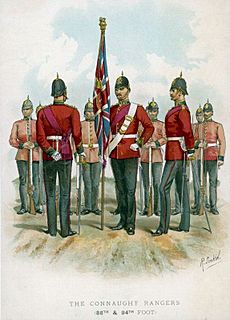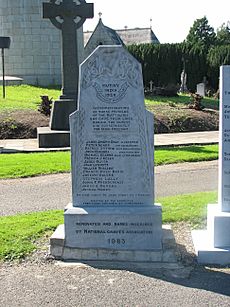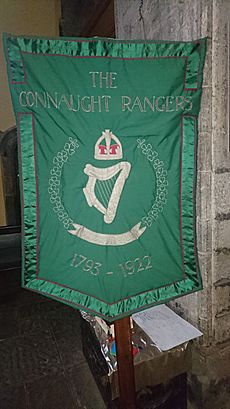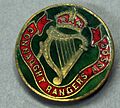Connaught Rangers facts for kids
Quick facts for kids Connaught Rangers (88th Foot & 94th Foot) |
|
|---|---|
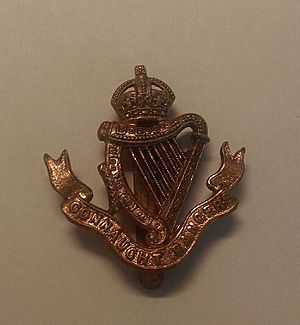
Connaught Rangers Cap Badge
|
|
| Active | 1881–1922 |
| Country | |
| Branch | |
| Type | Line infantry |
| Role | Infantry |
| Size | 2 Regular Battalions 2–4 Militia and Special Reserve Battalions |
| Garrison/HQ | RHQ – Renmore Barracks, Galway |
| Nickname(s) | The Devil's Own |
| Motto(s) | Quis Separabit (Who will separate us) (Latin) |
| March | Quick: Brian Boru March |
| Engagements | Egypt 1801; India; South America; The Peninsula; The Crimea; Indian Mutiny; South Africa 1877–1882; Egypt 1884–86; South Africa 1899–1902; The Great War – France & Flanders; Mesopotamia; Macedonia; Gallipoli; Bulgaria |
The Connaught Rangers ("The Devil's Own") was an Irish line infantry regiment (a type of army unit) of the British Army. It was created in July 1881. This happened when two older regiments, the 88th Regiment of Foot (Connaught Rangers) and the 94th Regiment of Foot, joined together. The 88th became the 1st Battalion, and the 94th became the 2nd Battalion.
The Connaught Rangers was one of eight Irish regiments in the British Army. Most of its soldiers came from Ireland. Its main base, called a "home depot," was in Galway. The regiment was officially ended in 1922. This happened after the Irish Free State became independent. Five other regiments with recruiting areas in the new Irish state were also disbanded at the same time.
Contents
The Connaught Rangers: A Brief History
How the Connaught Rangers Began
The Connaught Rangers regiment was formed in July 1881. It brought together the 88th Regiment of Foot and the 94th Regiment of Foot. This joining of regiments was part of a big plan to reorganize the British Army. These changes were known as the Childers Reforms.
The regiment was one of eight Irish units in the British Army. Most of its soldiers were recruited from Connacht, a province in Ireland. The main base for the regiment was Renmore Barracks in Galway. At this time, all of Ireland was managed as a separate military area within the United Kingdom.
When the new regiment was formed, the 88th Regiment was stationed in Bengal, British India. The 94th Regiment was in South Africa. As the 2nd Battalion, it returned to Ireland in 1882. A small group from the 2nd Battalion later joined the Nile Expedition in 1884. They served as soldiers mounted on camels. In 1896, the 2nd Battalion went to the Sudan. They were part of the force led by Lord Kitchener. This was during the reconquest of the Sudan. They then moved to India in 1897.
Fighting in the Second Boer War
The 1st Battalion went to South Africa. They were part of the 5th (Irish) Brigade. This brigade was led by Major-General Fitzroy Hart. The battalion fought in the Battle of Colenso in December 1899. This battle was an attempt to help the town of Ladysmith. Boer forces had surrounded Ladysmith.
The brigade suffered many losses in the battle. The Connaught Rangers had 24 men killed and 105 officers and men wounded. The Rangers also fought at Spion Kop in January 1900. They were also at the Tugela Heights in February 1900. These were more attempts by General Sir Redvers Buller to help Ladysmith. The siege of Ladysmith finally ended in late February. The 1st Battalion returned to India in 1903.
In 1908, the British Army changed how its volunteer and militia forces were organized. The Connaught Rangers then had three Reserve battalions.
The Connaught Rangers in World War I
Regular Army Battalions
The 1st Battalion was in Ferozepore, India, when World War I started. It was led by Lieutenant-Colonel Hurdis Ravenshaw. In September 1914, the battalion arrived in Marseille, France. They were part of the 7th (Ferozepore) Brigade. They fought on the Western Front.
The 2nd Battalion arrived in Boulogne-sur-Mer, France, in August 1914. They were part of the 5th Brigade. This brigade was in the 2nd Division. They joined the British Expeditionary Force on the Western Front. Their marching song, It's a Long Way to Tipperary, became very famous. By October, the battalion was fighting near Ypres. During one battle, Private Grogan bravely attacked seven German soldiers. He killed all of them, getting only a cut on his forehead and losing four teeth.
After many soldiers were lost in 1914, the 2nd Battalion was disbanded. The remaining soldiers joined the 1st Battalion. The 1st Battalion then moved to the Middle East in 1916. They fought mainly in what is now Iraq.
The 3rd (Reserve) Battalion stayed in Galway, Ireland, until November 1917. Then it moved to England. The 4th (Extra Reserve) Battalion was in Boyle, Ireland. It moved to Scotland in November 1917. This battalion was later combined with the 3rd Battalion in May 1918.
New Army Battalions
The 5th (Service) Battalion was formed in Dublin in August 1914. In August 1915, it landed at Anzac Cove in Gallipoli. They were part of the 29th Brigade. They moved to Salonika in September 1915 to fight on the Macedonian front. Then they went to Egypt in September 1917 to serve in Palestine. In June 1918, they arrived in Marseilles, France, to fight on the Western Front.
The 6th (Service) Battalion was formed in County Cork in September 1914. Many of its soldiers came from west Belfast. In December 1915, it arrived at Le Havre, France. They were part of the 47th Brigade in the 16th (Irish) Division. They fought on the Western Front. In just over a week of fighting in the Battle of the Somme in September 1916, the 6th Battalion lost many soldiers. They lost 23 officers and 407 other soldiers. On March 21, 1918, the same battalion was almost completely destroyed. This happened during the German spring offensive. In one week, the battalion lost "22 officers and 618 other ranks." Because of these heavy losses, the remaining soldiers joined the 2nd Battalion of the Leinster Regiment.
The Easter Rising of 1916
In April 1916, during World War I, a rebellion happened in Ireland. It was called the Easter Rising. Irish Republican forces fought against the British government. They wanted to create an independent Irish Republic. The Connaught Rangers and other British Army units were sent to fight these rebel forces. No Connaught Rangers were killed in this fighting, but one was wounded.
A group of 584 men from the 3rd Battalion Connaught Rangers marched to Enniscorthy. They were led by Lieutenant Colonel A J Digan. Rebels had taken over the town. However, the soldiers decided not to attack the rebels inside the town. They wanted to avoid turning Enniscorthy into a battlefield. After the rebellion started, the Connaughts patrolled the countryside. They looked for rebel groups. They captured hundreds of prisoners and took their weapons.
Another group of 250 Connaughts, led by Major H.M. Hutchinson, marched to Ferns on May 4, 1916. The next day, they went to Gorey. A small group of 31 Connaught Rangers, led by Lieutenant L.C. Badham, searched houses in Kinsale on May 4, 1916. The next day, they captured many rebels and their weapons. The Connaught Rangers also searched houses in New Ross on May 9, 1916, and then in Waterford the next day. They reached Clonmel on May 16, 1916. They searched more homes and captured more rebels and weapons.
Another group of Connaught Rangers, 422 men strong, was led by Major O.F. Lloyd. They searched houses in Bandon from May 6 to 11, 1916. They captured more rebels and weapons. This group then went to Clonakilty on May 11. They searched that area and captured more rebels and their equipment. This group marched to Skibbereen on May 16. They entered the town and searched the surrounding area. They rounded up even more rebels with their weapons. Some Connaught Rangers who were in Dublin during the Easter Rising volunteered to join other British Army units. They helped defend the city against the rebellion. Sergeant John Joseph Barror of the Connaught Rangers killed two rebels during the fighting in Dublin.
After the War: The Mutiny in India
After World War I, the Connaught Rangers became smaller. It went back to having two regular battalions. When the Irish War of Independence began in 1919, both battalions were outside Ireland. The 2nd Battalion was in Dover, England, and the 1st was in India. This was a plan to avoid problems with soldiers having divided loyalties during this time.
The 1920 Mutiny in India
On June 28, 1920, four soldiers from the 1st Battalion refused to obey orders. They were based at Wellington Barracks in Jalandhar, India. They were protesting against strict military rule in Ireland. One of the soldiers, Joe Hawes, had seen British forces stop a sports match in Ireland. Poor living conditions at the barracks might have also caused the protest.
Soon, other Rangers joined the protest. This included some English soldiers. By the next morning, over 300 soldiers were part of the mutiny.
On June 30, 1920, two mutineers from Jalandhar went to Solon barracks. There, they helped start another mutiny. This one was led by Private James Daly. His brother William also joined the protest.
At first, the protests were peaceful. The soldiers wore green, white, and orange ribbons. They sang Irish nationalist songs. But at Solon, on the evening of July 1, about thirty men led by James Daly tried to take their company's rifles. The soldiers guarding the weapons fired their guns. Two men were killed: Private Smythe, who was with Daly's group, and Private Peter Sears, who was hit by a stray bullet while returning to his room.
Within days, other British troops took over both barracks. Daly and his followers surrendered and were arrested. Eighty-eight mutineers faced a military trial. Seventy-seven were sent to prison, and ten were found not guilty. James Daly was executed by a firing squad on November 2, 1920. He was the last member of the British Armed Forces to be executed for mutiny. The bodies of Privates Sears and Smythe were buried at Solan. Daly and Miranda (another soldier who died in prison) were buried in a cemetery in Dagshai.
In 1923, after Ireland became independent, the imprisoned mutineers were released. They returned to Ireland. In 1936, the Irish government gave pensions to those who had lost their British Army pensions because of the mutiny. In 1970, the bodies of Privates Sears, Smythe, and Daly were brought back from India to Ireland for reburial.
The End of the Regiment
The Connaught Rangers regiment was disbanded on July 31, 1922. This happened because of big cuts to military spending. It also happened because the Irish Free State was established. On June 12, five regimental flags were placed in a special ceremony. This took place at St George's Hall, Windsor Castle, with King George V present.
After the regiment was disbanded, many of its former soldiers and officers joined the new National Army of the Irish Free State. They brought valuable combat experience. By May 1923, they made up a large part of the new army.
Memorials to the Connaught Rangers
In 1966, a special stained glass window was put in the new Galway Cathedral. This window honors the Connaught Rangers. There are also other memorials to the regiment and its soldiers in St. Nicholas' Collegiate Church in Galway.
Battle Honours: What the Regiment Achieved
The Connaught Rangers earned many "battle honours." These are special awards given to military units for their bravery and success in battles. Here are some of them:
- From the 88th Regiment of Foot: Egypt, Talavera, Busaco, Fuentes d'Onoro, Ciudad Rodrigo, Badajoz, Salamanca, Vittoria, Nivelle, Orthes, Toulouse, Peninsula, Alma, Inkerman, Sevastopol, Central India
- From the 94th Regiment of Foot: Seringapatam, Ciudad Rodrigo, Badajoz, Salamanca, Vittoria, Nivelle, Orthes, Toulouse, Peninsula, Pyrenees, South Africa 1877-78-79
- Second Boer War: Relief of Ladysmith, South Africa 1899–1902
- The Great War: Mons, Retreat from Mons, Marne 1914, Aisne 1914, Messines 1914 '17, Armentières 1914, Ypres 1914 '15 '17, Langemarck 1914 '17, Gheluvelt, Nonne Bosschen, Festubert 1914, Givenchy 1914, Neuve Chapelle, St. Julien, Aubers, Somme, 1916 '18, Guillemont, Ginchy, St. Quentin, Bapaume 1918, Rosières, Hindenburg Line, Cambrai 1918, Selle, France and Flanders 1914–1918, Kosturino, Struma, Macedonia 1915–17, Suvla, Sari Bair, Scimitar Hill, Gallipoli 1915, Gaza, Jerusalem, Tell 'Asur, Megiddo, Sharon, Palestine 1917–18, Tigris 1916, Kut al Amara 1917, Baghdad, Mesopotamia 1916–18
Victoria Cross Heroes
The Victoria Cross is the highest award for bravery in the British military. Three soldiers from the Connaught Rangers received this honor:
- Private Thomas Hughes - for actions in World War I on September 3, 1916
- Lance Corporal James Murray - for actions in the First Boer War on January 16, 1881
- Sergeant John Danaher - for actions in the First Boer War on February 12, 1881
Uniforms and Insignia
From 1881 to 1914, the Connaught Rangers wore the standard British infantry uniform. It was scarlet and blue. They had green "facings" (parts of the uniform like collars and cuffs). The green color was meant to show that they were an Irish regiment.
The regiment's buttons had a harp and crown design. This was surrounded by a shamrock wreath. The harp and crown also appeared on their cap badges. These badges were silver on a green background.
The Nickname: "The Devil's Own"
The Connaught Rangers were known by the nickname "The Devil's Own." This name was passed down from the 88th Regiment. People believed that Major General Thomas Picton gave the 88th this nickname during the Peninsular War. It was supposedly a compliment to their great bravery in battle. It also referred to their "irregularity in camp and quarters," meaning they were a bit wild when not fighting. However, there are no old records that actually show the 88th receiving this nickname. Later regimental histories also don't mention it or where it came from.
Images for kids


